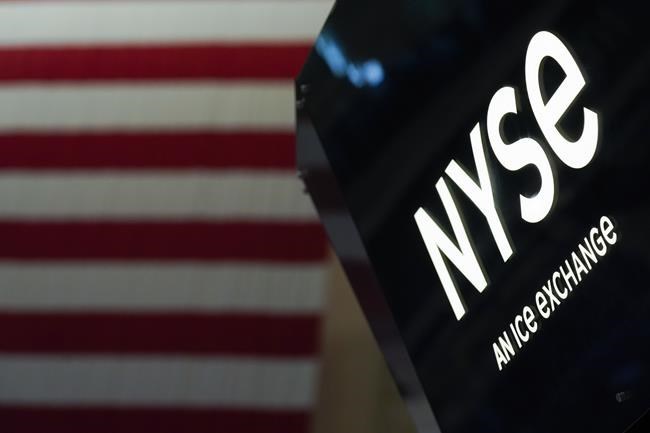NEW YORK (AP) — Stocks shook off a midday slump and ended higher on Wall Street, ending a four-day losing streak. The S&P 500 rose 0.5% Thursday. The Nasdaq composite and the Dow Jones Industrial Average also rose. Tech stocks helped lead the way after Nvidia reported better results for the latest quarter than expected. It’s a turnaround for tech and high-growth stocks, which have struggled recently because of worries about rising interest rates. They’re seen as some of the most vulnerable as the Federal Reserve jacks rates higher in hopes of stamping out inflation. Treasury yields fell.
THIS IS A BREAKING NEWS UPDATE. AP’s earlier story follows below.
NEW YORK (AP) — Stocks are drifting upward in late Thursday trading and back on track to break a four-day losing streak on Wall Street.
The S&P 500 was 0.6% higher after flipping between modest gains and losses through the day. The Dow Jones Industrial Average was up 105 points, or 0.3%, at 33,150, as of 3:05 p.m. Eastern time, while the Nasdaq composite was 0.8% higher.
Tech stocks were helping to lead the way after Nvidia reported better results for the latest quarter than expected. Its shares jumped 14.1% after it also gave a forecast for upcoming revenue that topped some analysts’ expectations. It cited recovering strength in video gaming and demand for artificial intelligence products.
It’s a turnaround for tech and high-growth stocks, which have struggled recently because of worries about rising interest rates. They’re seen as some of the most vulnerable as the Federal Reserve jacks rates higher in hopes of stamping out inflation.
High rates hurt investments seen as the riskiest, most expensive or whose big growth is furthest out in the future. They also raise the risk of a recession because they slow the economy.
After leaping in January, stocks broadly have slammed into a wall this month on worries that inflation isn't cooling as quickly or as smoothly as hoped. A lengthening list of reports have shown the economy is in stronger shape than expected.
While that's raised hopes about avoiding a recession in the near term, it's also forced a recalibration in forecasts on Wall Street for how high the Fed will take interest rates and then how long it will keep them there.
The latest economic data released on Thursday also suggested an economy with enough strength to encourage the Fed to keep up its campaign on rates. The fear is that a strong economy could feed into upward pressure on inflation.
Fewer workers applied for unemployment benefits last week than expected, another indication that the job market remains resilient despite the fastest increase in rates in decades.
A separate report said the U.S. economy’s growth was likely a touch weaker in the last three months of 2022 than earlier estimated. But it still grew at a 2.7% annual rate.
Sam Stovall, chief investment strategist at CFRA Research, said stronger economic data going back to this month's jobs report pushed him to add one more rate hike to his forecast before the Fed takes a pause. He also pushed out how long he thinks it may take the S&P 500 to get to his target level of 4,575. Instead of thinking it could happen by the end of this year, he thinks it could be 12 months from now.
“The bond market has been pretty pessimistic right from the start, assuming that inflation would be higher for longer, that we do have the likelihood of a recession,” Stovall said.
“Our belief is that it probably won’t be a repeat of the Great Recession. In terms of timing, it could actually be fairly similar to the recession of 2001. It could end up being fairly short and happens 14 months after the start of the bear market” for stocks.
Wall Street’s heightened expectations for the Fed have been most evident in the bond market, where Treasury yields have shot higher this month. They were easing a bit on Thursday and taking pressure off stocks.
The yield on the 10-year Treasury, which helps set rates for mortgages and other important loans, dipped to 3.88% from 3.93% late Wednesday.
Earlier this week, it topped 3.95% as it raced toward its highest level since November.
On the losing end of Wall Street was Moderna, whose shares slid 6.9% after it reported its fourth-quarter profit tumbled 70% as COVID-19 vaccine sales fell and the drugmaker caught up on a royalty payment.
Domino's Pizza dropped 11.5% despite reporting stronger profit than expected. Its revenue fell short of forecasts, and it lowered the top and bottom ends of its forecasted range for global sales growth in the next two to three years.
Lordstown Motors tumbled 12.2% to $1.08 after it said it's temporarily halting production and deliveries of its Endurance electric pickup due to performance and quality issues with certain components.
———
AP Business Writers Joe McDonald and Matt Ott contributed.
Stan Choe, The Associated Press



